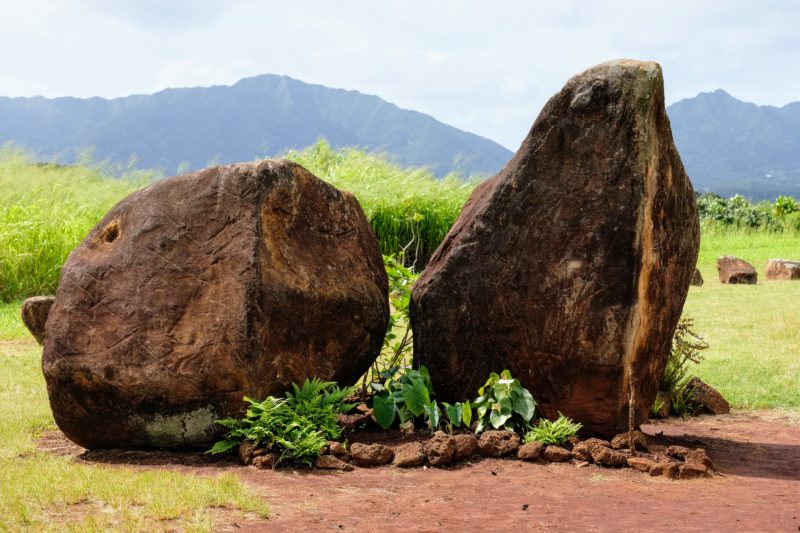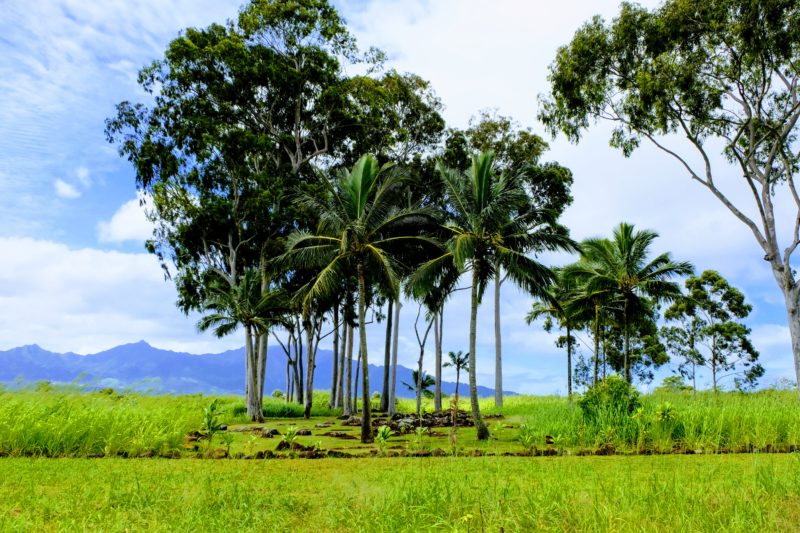This post may contain affiliate links, which means I'll earn a small commission if you purchase something through these links. You won't pay any extra; instead, you'll be helping Aloha With Love to thrive. Thank you! Learn more.
--
Update: This has been “temporarily closed” for a few years now. Please check in advance for any updates.
Let me put the Kukaniloko birthstones into perspective for you. Imagine you’re a chief. Royalty of the highest status. You are determined to make the trek out to the royal birthstones. Why? Because it’s a sacred place that would signify your child’s birthright and privilege to be high-born.
Like any culture, your status in life said a lot about you, your family, your worth and your future. It’s that first building block parents invest in their children to ensure their success and their family line.
Of course, it wasn’t so simple as popping out a baby on a rock. (Who said it’d be easy?) A lot went into the ceremony and the Kukaniloko birthstones are deeply tied with Hawaiian culture, history and tradition.
Aloha with love,
Amy
Local Tip: The Hawaiian Civic Club of Wahiawa comes out every 3rd Saturday to cut grass, so the best time to see the Kukaniloko birthstones is right after. If you come by right before, a lot of your view will be blocked by tall California grass that can grow several inches in a day. And if it’s been raining recently? You can forget having a good view because the grass will not only block your view, but also stop you from walking around the birthstones.
Watch This Video Before You Go To The Kukaniloko Birthstones
This video is old, but you won’t find a better online resource to see how important Kukaniloko was (and still is) to the Hawaiian culture. Tom Lenchanko, a caretaker of Kukaniloko takes you in and introduces several stones that show how Hawaiians used Kukaniloko as a compass, a map of Oahu, an astrological guide, an educational center and even as a sundial. The multiple uses of this Hawaiian “Stonehenge” from the 12th to 17th centuries will blow your mind.
Local Tip: You can watch this now to get excited about Kukaniloko, but I recommend watching this again the day before you come here. You’ll be able to identify the stones on sight and will imagine ancient Hawaiians using the stones to teach, learn and preserve.
Giving Birth At Kukaniloko
There are 36 stones lined up in 2 rows (18 stones in each). These stones symbolize the 36 alii (chiefs) who were witnesses to this momentous birth of the next in a royal bloodline (Dad was 1 of the 36). There was also one stone that was reserved for the leading lady while giving birth.
Nowadays, they suspect that some of the stones have shifted or fallen to their side over time. This is probably due to time and weather, but the sight of the Kukaniloko birthstones will still transport you to a different time in Hawaiian history.
There are a couple of reasons why this particular spot was chosen. If you were to locate the Kukaniloko birthstones on a map of Oahu, you’d see that this spot is central to Oahu. The area was also considered to have plenty of spiritual energy – the perfect place to birth powerful offspring.
Historical Fact: Not all chiefs were allowed to give birth here. Those who practiced human sacrifice (yikes!) or whose genealogy couldn’t quite be proven weren’t allowed.
While it’s said up to 48 alii could witness the birth, retainers and kahuna (priests) were also present to aid the birthing. The kahuna were responsible for the ceremonial rituals before and after the birth. The retainers helped with the actual birthing and kept her off the ground by carrying and supporting her legs as they let gravity do the work. It was not allowed for her to touch the ground – instead with the help of the retainers, she would float above a particular stone and give birth.
As soon as the baby was born, they packed Mom and the royal infant back up into the litter and rushed them over to nearby Hoolonopahu heiau (a Hawaiian temple) where a kahuna would split bamboo with their teeth and use it to cut the umbilical cord. Drums would sound and the people in the surrounding area would celebrate.

Kukaniloko Wasn’t Just A Birthplace. It Was The Center Of Everything.
If you have the opportunity to look closer, you’ll see stones with serrated edges, sharp angles or carved out crevices. These were used as educational tools for navigation and the stars.
Using the sun, shadows and light would indicate months, hours, and time. Each stone wasn’t just placed willy nilly either. Using a special method to line up stones, imaginary lines would point to significant locations around Oahu.
You won’t be able to see these stones up close since you’re not allowed to enter in this sacred area, but you can spot the stones that are pointed out in the video based on their shape, which is cool. From there, let your imagination take over as you envision babies being born and classes being taught.

Watch Your Step, Kukaniloko Is Sacred
Every 3rd Saturday until about noon, the Hawaiian Civic Club of Wahiawa devotes precious time and effort to the upkeep of this culturally important gem. Tall grasses easily overtake the entire area and block your view if everything is overgrown.
There’s a barrier of rocks lined up along the perimeter of the stones that mark where you are and aren’t allowed to step foot. And if that isn’t enough to deter you, there are signs labeled “no public access” dotted along all 4 sides.
If the grass is short, it won’t take you more than 5 minutes to stroll around the birthstones. The highest I’ve seen the grass is over 4 feet tall after several days of heavy rain and I can promise that walking around will be more trouble than it’s worth. The grass can cover the stones blocking your view entirely – another good reason to time your visit after the 3rd Saturday of each month.
Local Tip: If you have binoculars or a zoom lens, take a closer look. You can see many of the stones in the video including the serrated diamond-shaped stone!

How To Get To Local Gem Kukaniloko
As you make your way to Haleiwa and the North Shore, pass through Wahiawa – an old plantation town back in the day. When you exit out on Kamehameha Highway, you’ll pass over a bridge and the scenery will open up to wide and flat plantation fields.
The first traffic light you come upon is where the Kukaniloko birthstones are. The trailhead is on your left at the traffic light but there is no parking lot. You can either take a right or head straight and do a u-turn, drive back to the trailhead and park on the grass on the side of the road.
The dirt trailhead is visible right away and you just have to walk straight for a couple minutes before you see 2 large stones marking the entrance.
If you intend to return the same way, you can choose to visit Kukaniloko on your return instead. This option is much easier since you’ll be traveling in the direction of the parking already. You don’t have to worry about a crowd here. I’ve only ever seen 2 or 3 other people each time and most will only walk around and return.
Local Tip: While I encourage visitors to come after the 3rd Saturday to have a clean view of Kukaniloko, if you come on the 3rd Saturday in the morning, you’ll probably run into the caretakers and volunteers. I happened to have a lovely chat with a woman caring for the plants at this gate marker. She shared a few facts with me and gave me an even deeper understanding of Kukaniloko.

Are The Kukaniloko Birthstones On Your List?
There are 2 types of visitors who visit the Kukaniloko birthstones. The ones who only know that these are “royal birthstones” and the ones who have done their research. The first group won’t spend more than 15 minutes here. All they’ll see is a pile of uninteresting rocks.
But for those of you who have read this article, watched the video (please do!) and find it fascinating how ancient Hawaiians were able to figure out and plan this exceptional map/guide/school – you will be amazed, I promise!


Gerçek hiçbir zaman şiddet tarafından çürütülemez. -E. Fromm